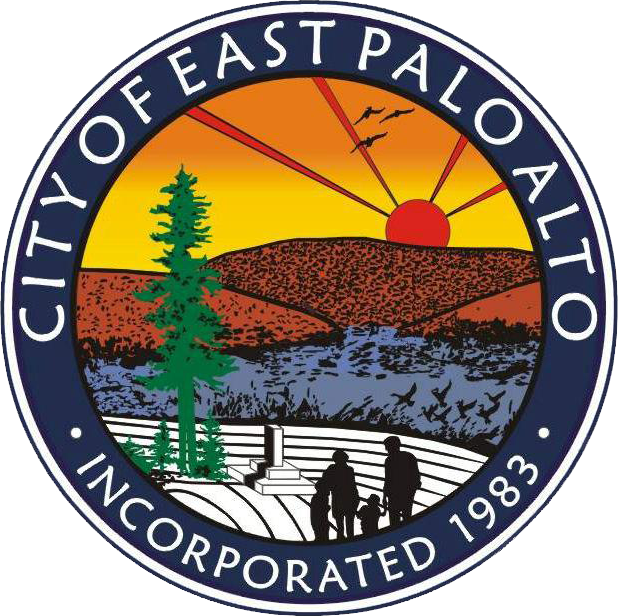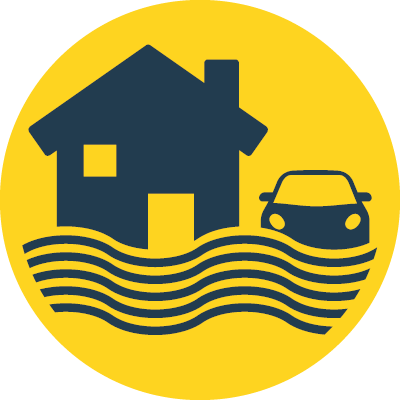
East Palo Alto
The City of East Palo Alto is at the southernmost edge of San Mateo County. East Palo Alto has a Mediterranean climate with cool, wet winters and warm, dry summers. The community and its surrounding area includes many important natural features, such as the Baylands, San Francisquito Creek, and the shoreline of the Bay. These natural features act as landmarks establishing a strong sense of place and location within the community. The City of East Palo Alto is already experiencing the effects of climate change, including extreme heat and wind events during the summer and fall and flooding in the winter months. Other concerns are extended periods of drought and sea level rise.
East Palo Alto began to develop as a primarily residential suburban community after World War II, when Black migrants moved into the area to take advantage of low-cost housing and because, unlike surrounding peninsula communities, the area had few racially restrictive housing covenants. East Palo Alto incorporated in 1983, led by a diverse coalition of residents and arising from a movement for social and fiscal self-determination following years of marginalization and neglect. Today, Latino, Black, and Pacific Islander residents represent the largest ethnic groups in East Palo Alto, making it one of the most multicultural and multilingual communities in the San Francisco Bay Area.
The City of East Palo Alto and its local community partners will be hosting a round table discussion on December 5th, 2024, to talk about hazards and safety issues. The PREP project team wants to make sure that all communities have a voice in the local planning process. This discussion will be conducted in English. If you are interested in attending, please click the button below for more information and the registration link.
East Palo Alto Safety and Environmental Justice Workshop | July 28, 2025
East Palo Alto, in partnership with CRC and Nuestra Casa, is hosting an in-person workshop to plan for a safer, healthier, and more resilient community. This workshop will cover safety and environmental justice topics. Please join us to learn about this project and share your thoughts on draft goals and priorities. The workshop will be from 6 to 8 pm on July 28, at the City Council Chambers (2145 University Avenue in East Palo Alto). Click here for more information. Pulse aquí para más información.
Local Safety and Resilience Highlights

Seismic and Geologic Hazards
The San Andreas Fault is located approximately six miles to the west of the city boundary. This is the predominant fault system in California and has generated some of the largest and most destructive earthquakes in the state’s history. Ground shaking could bring widespread and serious damage to East Palo Alto. The presence of unreinforced soft-story buildings, concrete tilt-up buildings, and unreinforced masonry further exacerbates the community’s seismic risk. The majority of the city is also susceptible to moderate to high levels of liquefaction, with the areas at greatest risk of liquefaction located in the bay shoreline areas and along US 101 and San Francisquito Creek.
East Palo Alto is also vulnerable to subsidence, or failure or collapse of the existing ground surface. Over time, differential settlement can result in substantial damage to buildings and structures. Areas of East Palo Alto that are comprised of former tidal flats could be susceptible to subsidence where low-strength native soils are immediately adjacent to loose or unconsolidated fill.

Sea Level Rise and Flooding
Sea level rise resulting from global climate change has the potential to alter the frequency and magnitude of flooding in low-lying areas of East Palo Alto. Sea level rise will make the City increasingly vulnerable to inundation during both normal high tides and major storm events, inundating both industrial and residential areas. East Palo Alto has a history of shoreline flooding due to its low-lying location along the San Francisco Bay, particularly in areas along San Francisquito Creek. Flooding has occurred primarily because of high tides, rain flowing down the San Francisquito Creek, and a limited storm drain system. High tides combined with winds from the east that create storm surge or wave run-up could lead to widespread and significant flooding, especially if precipitation exceeds the Creek’s capacity to carry floodwaters to the Bay.
East Palo Alto has a history of flooding problems due to its low-lying location along the bay, particularly in areas along San Francisquito Creek. As of 2015, many of the streets in East Palo Alto lack storm drains. Where storm drains exist, they lack the capacity to handle stormwater during heavy rain events. During major storm events in East Palo Alto, storm drains can overflow, flooding streets, and leaving parts of the city effectively stranded. Low-lying areas face extra risk of floods related to levee breaks, ruptures, or overtopping.

Hazardous Materials
Hazardous materials are materials that pose a significant risk to public safety or human or environmental health. These include toxic chemicals, flammable or corrosive materials, petroleum products, and unstable or dangerously reactive materials. A release or spill of hazardous materials could result in fire, explosion, toxic cloud, or direct contamination of water, people, and property.
Numerous studies and plans have identified several different types of hazardous material contamination in East Palo Alto. The greatest concentration of affected sites is in the Ravenswood Transit-Oriented Development (TOD) Specific Plan Area, centered around Bay Road and the Cooley Landing area. This area was historically home to numerous industrial uses dating back to the nineteenth century. Many historic industrial sites have moderate to substantial contamination of soils and groundwater, as the handling, use, and disposal of hazardous materials were not as tightly regulated as they are today. Polychlorinated biphenyl (PCBs, a carcinogen), metals, petrochemicals, and other harmful materials can be found at such sites. Many of these sites are currently undergoing cleanup activities, and others have restrictions that prohibit sensitive uses like homes or schools from being placed on top.
Local Links
- City of East Palo Alto Safety Element Update
- City of East Palo Alto General Plan
- San Mateo County MJLHMP - East Palo Alto
- Green Infrastructure Plan
- Climate Action Plan
- San Francisquito Creek Bank Stabilization and Revegetation Master Plan
- San Francisquito Creek Comprehensive Plan
- Acterra Community-Based Vulnerability Planning Pilot Project Report
- Ravenswood Business District/4 Corners Specific Plan Update